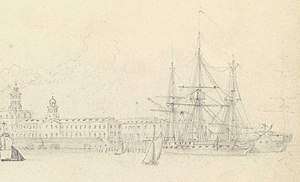HMS Pyramus (1810)
HMS Pyramus was a fifth-rate 36-gun frigate launched at Portsmouth in 1810. During the Napoleonic Wars she captured some small privateers. She was hulked in 1832–1833 at Halifax, Nova Scotia. The vessel was sold and broken up in 1879.
 HMS Pyramus at Portsmouth Dockyard on 6 September 1825, drawn by John Christian Schetky | |
| History | |
|---|---|
| Name: | HMS Pyramus |
| Ordered: |
|
| Builder: |
|
| Laid down: |
|
| Launched: | 22 January 1810 |
| Fate: | Sold for breaking up in September 1879 |
| General characteristics [1] | |
| Tons burthen: | 92020⁄94 (bm) |
| Length: |
|
| Beam: | 38 ft 5 in (11.71 m) |
| Depth of hold: | 12 ft 0 in (3.66 m) |
| Sail plan: | Brig |
| Complement: | 264 |
| Armament: |
|
Origin
Pyramus was the sole member of her class and was built on the lines of the French frigate Belle Poule, which the Royal Navy captured in 1780. She was ordered in 1805 and laid down the next year, but in 1807 the builder failed. The Admiralty transferred the frame to the Portsmouth Dockyard. The Admiralty reordered her and she was launched in 1810.
The information that Lord Nelson had captured Pyramus at the Battle of Copenhagen in 1801 is incorrect. (Source Dr. Ian A. Cameron, M.D, F.C.F.P., Nova Scotia Medical Bulletin, August 1987, pp. 118–120; Also, the Cambridge Digital Library / University of Cambridge website)[2][3][4][5]
Career
On 26 October 1813, Hotspur and Pyramus captured the 225 ton (bm) American letter of marque Chesapeake off Nantes. Captain Joseph Richardson had sailed her from America to France and she left Nantes on 18 October 1813.[6][Note 1]
Fate
Pyramus was laid up in 1829. Between November 1832 and July 1833 she underwent fitting for a convict and receiving ship for Halifax, Nova Scotia. From 1834 to 1875 she was at Halifax.[1] She served as a hospital ship during the Chorea Epidemic.[8]
On 10 November 1879 she was sold for £1,600 for breaking up.[1]
Notes, citations, and references
Notes
- She had been commissioned at Baltimore on 7 July 1813. She had a crew of 33 and was armed with one 18-pounder gun and four 12-pounder carronades.[7]
Citations
- Winfield (2008), pp. 174–175.
- https://novascotia.ca/archives/royalnavy/archives.asp?ID=32
- "Documents of the Assembly of the State of New York". 1867.
- The Naval Chronicle: Volume 23, January–July 1810: Containing a ..., Volume 23
- British and Foreign Medico-chirurgical Review: Or, Quarterly Journal of Practical Medicine and Surgery, Volume 35
- Cranwell & Crane (1940), p. 157.
- Cranwell & Crane (1940), p. 377.
- Erickson (1986), p. 22.
References
- Cranwell, John Philips, & William Bowers Crane (1940) Men of marque; a history of private armed vessels out of Baltimore during the War of 1812. (New York, W.W. Norton & Co.).
- Erickson, Paul A. (1986) Halifax's North End: an anthropologist looks at the city. (Lancelot Press)/
- Winfield, Rif (2008). British Warships in the Age of Sail 1793–1817: Design, Construction, Careers and Fates. Seaforth Publishing. ISBN 1-86176-246-1.CS1 maint: ref=harv (link)